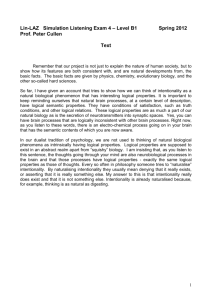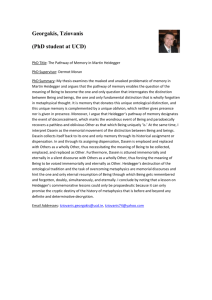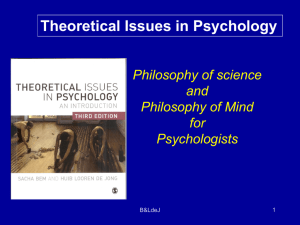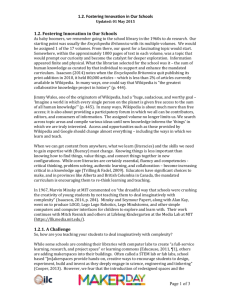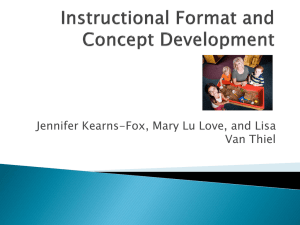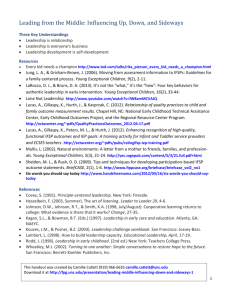Love and Death - WesFiles
advertisement
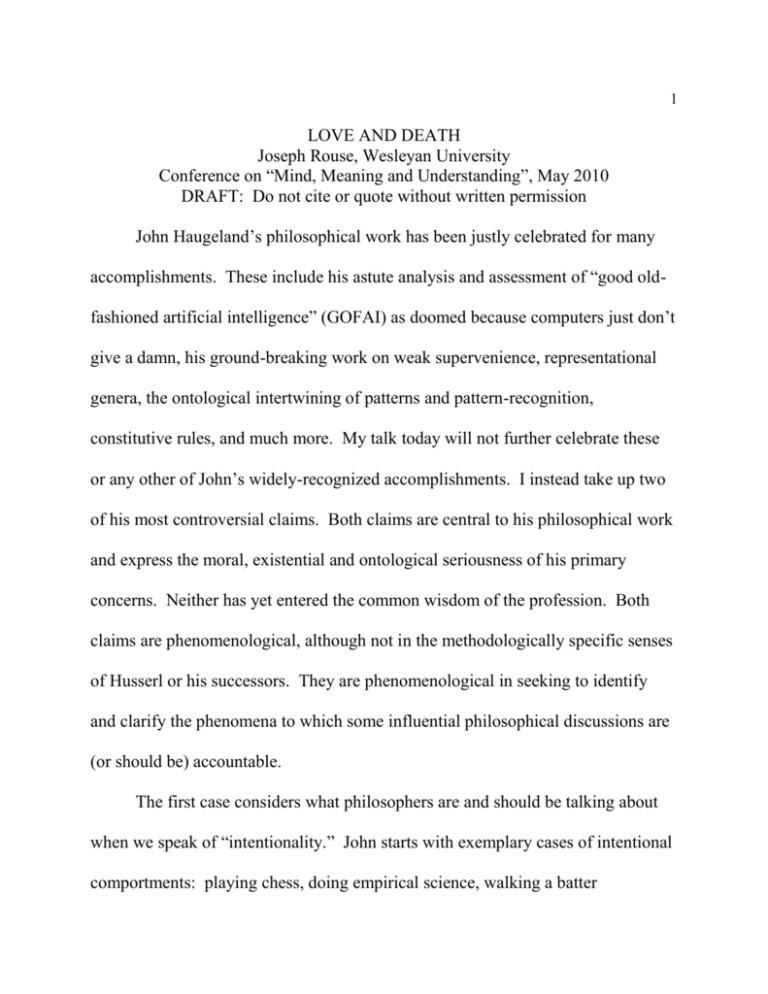
1 LOVE AND DEATH Joseph Rouse, Wesleyan University Conference on “Mind, Meaning and Understanding”, May 2010 DRAFT: Do not cite or quote without written permission John Haugeland’s philosophical work has been justly celebrated for many accomplishments. These include his astute analysis and assessment of “good oldfashioned artificial intelligence” (GOFAI) as doomed because computers just don’t give a damn, his ground-breaking work on weak supervenience, representational genera, the ontological intertwining of patterns and pattern-recognition, constitutive rules, and much more. My talk today will not further celebrate these or any other of John’s widely-recognized accomplishments. I instead take up two of his most controversial claims. Both claims are central to his philosophical work and express the moral, existential and ontological seriousness of his primary concerns. Neither has yet entered the common wisdom of the profession. Both claims are phenomenological, although not in the methodologically specific senses of Husserl or his successors. They are phenomenological in seeking to identify and clarify the phenomena to which some influential philosophical discussions are (or should be) accountable. The first case considers what philosophers are and should be talking about when we speak of “intentionality.” John starts with exemplary cases of intentional comportments: playing chess, doing empirical science, walking a batter 2 intentionally, or speaking a natural language. He then argues that many prominent and influential theories of intentionality not only to fail to account for these paradigmatic cases. Their apparent plausibility arises from describing some other phenomenon that mimics but falls short of genuine intentional directedness. Philosophical reflection has thereby missed the distinctiveness of human intentional comportments, even in these familiar examples. In constructive response to these failures, he offers the striking but puzzling slogan that “love is the mark of the mental.” The second case initially seems to involve textual interpretation, rather than phenomenology. Heidegger devoted chapter 1 of Division II of Being and Time to existential death, or “being-towards-death.” On anyone’s reading, existential death must be distinct from both the cessation of biological functioning (perishing), and the loss of recognition and abdication of commitments that is a person’s social demise. Almost all commentators nevertheless conclude that perishing, demise, and existential death, while distinct and separable, are closely related. Each concerns different aspects of or orientations toward the end of an individual human life. John will have none of this. He instead locates existential death in the neighborhood of Kuhn’s account of the persistent vulnerability of normal science to crisis and revolution, Popper’s insistence upon the empirical falsifiability of any legitimate scientific theory, or the “death” of a natural language when no one 3 speaks or learns it anymore. Existential death is then the utter collapse of the intelligibility made possible by what Heidegger called an “understanding of being.” Such a collapse of intelligibility in our own comportments inevitably seems literally impossible, and when confronted with the apparently impossible, we seek to explain it away. Rightly so. Yet John takes the responsibility to own up to the genuine possibility of the impossibility of any intelligible intentional directedness to be Heidegger’s understanding of Dasein’s existence as beingtowards-death. These two sites of controversy, intentionality in the philosophy of mind, and death in existential phenomenology, may seem far apart. Yet John understands love as the mark of the mental and being-towards-death as the same issue viewed from two directions. Perhaps only that well-known former NYU philosophy student, Woody Allen, has previously proposed a philosophical convergence of love and death, and then only facetiously. I nevertheless think John is onto something importantly right about both issues. I will indicate why I think so, without arguing for either claim in detail. I will instead show what I think John is claiming in each case, and why these two discussions are reciprocal. In the last part, I briefly indicate some directions in which John’s treatment of intentionality as love and death should lead us. This final consideration is especially important. I do not just want to look back and celebrate John’s philosophical 4 accomplishments, as if settled and done. I instead emphasize how his work should be taken up and carried on. In pressing into the possibilities John has opened, I will note points where John and I differ. I raise them less as objections, however, than as strategies for building upon what he has done. I — Intentionality and Love John presents two widespread phenomena as importantly misleading simulacra of genuine intentionality: “ersatz intentionality” and what I shall call “lapsed intentionality.” In some respects, each mimics genuine intentional directedness. Yet each nevertheless lacks a crucial dimension of the genuine phenomenon, even in its most ordinary instances. Since John thinks many prominent accounts of intentionality actually account for these simulacra instead, his descriptions have both critical and constructive import: they call attention to aspects of intentionality that John takes these philosophical theories to obscure. To grasp these connections, however, we need to consider briefly John’s broader critical challenges to other philosophical theories. His arguments, in Having Thought and elsewhere, typically address whole families of philosophical theories rather than their specific instances. We must therefore understand the relevant forms of philosophical kinship. I think his recent arguments implicitly map the field via two distinctions. The first distinguishes descriptive from normative approaches to understanding intentionality. A descriptive approach 5 would identify features of intentional comportments that produce their directedness toward objects. Salient examples include Fodor on representations that function in cognition, Husserl on correlated noetic acts and noematic senses, Searle on intentionality as a complex biological property, Millikan’s teleo-semantics, Dreyfus on practical coping, or Dretske on primary information-bearing features of cognitive states. A normative approach, by contrast, identifies intentional comportments with performances and capacities that can be held accountable in the right way. Intentional performances or states can be held accountable to relevant standards, and are intentional in virtue of how they would stand up to such accounting. For example, intentional systems might be those interpretable as mostly rational in context. On normative accounts, not all intentional states or performances actually deploy the constitutive forms of accountability (e.g., reflection, or interpretation by others). Thus, for example, chess grandmasters playing blitz chess need not have chess concepts “in mind” when responding to a position with a rapid move, so long as their moves are appropriately accountable to the regulative, constitutive and strategic norms of chess play. Normative approaches include Brandom on the game of giving and asking for reasons, Davidson on radical interpretability, McDowell on conceptual understanding, Heidegger on care and Eigentlichkeit, or Haugeland himself on existential commitment. 6 A second dividing line draws upon Husserl’s distinction between empty and fulfilling intentional comportments. An empty intending is directed toward an object in its absence, whether as non-existent or as failing to satisfy its aspectual presentation. By contrast, a fulfilling intending presents the object itself as directly manifest. This sense of fulfillment need not be infallible, however. Some intentional states or performances can present objects in ways first-personally indistinguishable from perception, and yet not be a fulfilling intending. 7 Husserl’s distinction then highlights two opposing ways to understand intentionality. A common philosophical approach starts with the content of intentional comportments, and then asks what it is for such content to be fulfilled. The need to understand non-referring and erroneous presentations seemed to dictate beginning with their sense before asking how objects can fulfill a sense. Alternatively, one starts with a system’s actual relations to entities, and asks what it would be for those relations to be intentional. The challenge has been to show how actual interaction with one’s surroundings can open a space of articulated, 8 normative engagement. The most common motivation for this second strategy has been “baldly” naturalistic, in McDowell’s phrase. Intentionality is attributed to some entities, states or performances that are causally or functionally interactive with their surroundings. One then asks how such causal interactions can be intentionally directed, under an aspect, such that what the system does could be in error. It must, after all, be possible for an intentional system to “mean” something other than what it actually interacts with. Dretske’s appeals to information-bearing states or Millikan’s teleosemantic functional norms are familiar examples. Yet Heidegger also begins with intentional fulfillment (an understanding of being exhibited in an ability-to-be) without construing fulfillment in causal or other baldly naturalistic ways. Dreyfus on practical/perceptual coping, and McDowell’s “direct realist” account of perception as rational second nature, also start with a fulfilling intentional comportment, without espousing a “bald naturalism.” We can combine these two distinctions in a 2 x 2 array, shown on your handout, that sorts approaches to understanding intentionality by their location on that grid. John primarily argues against the B1 and A2 strategies (having relegated the A1 strategies to the “outfield” of intentionality). Broadly speaking, the problem 9 with the A2 conceptions is a failure of meaning. Although they characterize comportments that actually and effectively respond to their surroundings, John concluded that “there is nothing that the response can “mean” other than what actually elicits it in [its] normal [functioning] in normal conditions” (HT 310). The B1 approaches fail in the opposite direction, by not accounting for truth and error. Their systematically interconnected comportments seem to constitute a meaningful conception, but cannot actually be conceptions of anything, because they are only accountable to their own further comportments. On the B1 accounts, actions, thoughts and utterances could at best exhibit “mere coherence” among their own performances, without accountability to objects. The B1 and A2 groups are each associated with distinctive simulacra. The best A2 approaches account for what John calls “ersatz intentionality.” Non-human animals, at least those with relatively flexible, non-sphexish behavioral repertoires, are the paradigm case. Yet John also thinks some products of AI research exhibit a similar engagement with their surroundings. It is telling that AI systems cannot achieve even ersatz intentionality without a body enabling them to move and act. Thus, AI robots, not AI programs, exhibit ersatz intentionality. Both animals and sophisticated robots display behaviors that resemble genuine intentional comportments, needing careful analysis to tell the most interesting cases apart. The best B1 approaches (John takes Brandom and Davidson as exemplary) also characterize a real phenomenon. “Lapsed” intentionality falls short of the real thing in a different way. Unlike ersatz intentionality, it presupposes the achievement of genuine intentional directedness. Yet it also systematically avoids or conceals a crucial dimension of its own presupposed achievement, namely its accountability beyond its own interconnected performances. What lapsed intentionality seeks to avoid in practice, with only partial success, the B1 theories erase in principle. These theories thus ironically idealize a problematic tendency within genuine intentional engagement. This tendency has been variously described and evaluated. Heidegger presented one version, “falling,” articulated as idle talk, curiosity and ambiguity, as an inescapable tension within Dasein’s disclosedness. Harry Frankfurt (2005) characterized a similar phenomenon, “bullshitting,” as only a lamentable and preventable lapse. Ian Hacking (1992) has instead celebrated a related tendency within science practice as the “self-vindication” of experimental practice. Both descriptive terms, “ersatz” and “lapsed,” are fighting words that would be rejected by the theorists they target. If various human activities are paradigm cases of genuine intentionality, then no surprise that what non-human animals and sophisticated robots do resemble those capacities. We, after all, are animals. AI robots, in turn, reflect sustained, sophisticated attempts to match some of our intentional capacities. The challenge for John’s view is to show in what sense animal and robotic behaviors nevertheless only simulate genuine intentional comportments. He likewise must show what is obscured by inadvertently identifying genuine intentionality with something like idle talk. Consider animals. They exhibit a sustained and often highly flexible purposiveness toward their surroundings. They constitute themselves as entities by coordinated processes that differentiate them in a non-arbitrary way from other things. Moreover, they are not merely differentiated from other entities. As organisms, they also engage an environment, in a sense distinct from a collection of entities in their vicinity. An organism’s environment is the interconnected aspects of its surroundings that matter to its ongoing way of life. It responds to things by eating them, avoiding them, mating with them, concealing other things beneath them, and so forth. Organisms’ behavior responds to the features of their surroundings that they need to take into account as the kind of organism they are. Moreover, animals respond in a systematically self-directed way, by movements that track and respond to what matters to them. Some animals, in turn, devise flexible strategies united by their common end, and adjust their behavior in response to failures to attain it. Robots achieve similar selectivity via functional design and a focused interface between their capacities for detection and response. No surprise that goal-directed teleology and adaptation figure prominently in many A2 theories. So in what sense are these sophisticated, flexible, purposive, self-corrective responsive repertoires merely “ersatz?” Several interconnected features ground John’s insistence upon sharply differentiating non-human animal behavior from genuine intentionality. First, non-human organisms respond to their surroundings “narcissistically,” in Kathleen Akins’s (1996) telling term. Perceptual/practical systems (our own included) do not discern or register objective features of things, but only respond to how those things matter to their own functioning. Thus, bodily thermo-receptor systems don’t register or respond to the ambient temperature, but only to a more gerrymandered set of features defined by their effect upon the organism’s way of life. Interestingly, such narcissism may also characterize successful AI systems: my Wesleyan computer science colleague Eric Aaron achieves some robust successes in dynamic navigation programming by also directing robotic agents toward such narcissistically-specified features. Second, non-human animal behavior remains closely tied to its actual circumstances, with no space for symbolic displacement. A vervet monkey’s distinctive warning cries in response to different predators, for example, directs attention toward an actual location, and prompts a characteristic response. Absent such circumstantial ties, the warning cries would be pointless. Such comportments are thus high-level, complex patterns of differential responsiveness to actual configurations of the world. One can assess individual organisms’ abnormal responses with respect to what is normal, but that leaves no standard for assessing the overall pattern of normal responsiveness. Third, organisms’ purposive directedness outward is circumscribed by its own way of life as a relatively fixed “end.” Here I must be careful, because many organisms do have significant abilities to alter their behavior in response to things. As Mark Okrent reminds me, cats must learn to discriminate the indigestible ferrets from the comestible mice among “small, furry rodent-y things.” Yet these patterns still only exhibit what John calls “first-order self-criticism” (2002). Cats can revise and repair their own behavior with respect to their normal functioning as the kind of organism they are. They cannot, however, revise those norms in response to how things show themselves. Those first-order skills for learning are thus assimilable within their normal functioning. Normal cats do learn not to eat ferrets after a small number of trials, but that is no basis to assess that adaptation as a failure in comparison to a possible pattern in which ferret avoidance is completely genetically assimilated. It could only become a “failure” in a limited sense, if it could not reproduce itself successfully in a different environment that actually incorporated other cats with such an altered pattern of development. But why isn’t first-order self-criticism good enough? In several crucial respects, it is better than good enough. Non-human organisms do not lack genuine intentionality, just as fish notoriously do not lack bicycles. Nor does proper moral regard for animals require their philosophical assimilation to our own selfunderstanding. Yet I do agree with John that familiar non-human organisms do not comport themselves intentionally toward other entities (or themselves). Remember that the goal-directedness of an organism is holistic. We think that organisms take some things in their environment as food, because of the relatively good match between what they eat and what is “edible.” But there are many edible things they do not eat, even when hungry. Sometimes individual organisms make mistakes relative to their normal pattern. But some cases may not fall in their normal pattern of recognition-and-response, perhaps because the discriminative capacity would be too energetically or cognitively costly. In that case, they don’t respond to what they do eat “as food,” but “as energetically-and-cognitively-accessible food.” But of course, that category also has exceptions, which must in turn be added in a more complex description. There is no principled stopping point to that process of qualifications to the supposed as-structure of the organism’s behavior, short of its entire normal behavioral pattern in response to its normal environmental range. Analysts of an organism’s behavior can of course explain its reproductive success in that environment, by discriminating components of its functioning that differentially contribute to evolutionary success. But these classifications invariably treat some aspects of the organism’s normal behavior as “noise” or ceteris paribus violations, which are only “exceptions” with respect to the analyst’s categories and norms. For organisms, the exceptions equally belong to what they normally do. Moreover, the problem is worse, because even if actual behavior perfectly mapped onto the analyst’s classifications in the actual environment, it would almost surely diverge under counterfactual conditions not part of their evolutionary history. Such counter-factual accountability is nevertheless crucial for intentionality. That was why Bert Dreyfus’s (1979) objection that Roger Schank’s restaurant scripts could not handle questions that were “off-script” was so telling against that iteration of AI. John similarly asked how dogs would respond to “impossible” permutations in the facial features of its human family. Genuine intentional directedness must be modal, to express a “non-accidental” directedness and accountability. Circumstantial coincidence, even evolutionary coincidence is not enough. Of course, genuinely intentional systems also diverge from what is appropriate for them, often rather more so than well-adapted organisms. What nevertheless lets a genuinely intentional system be toward an aspect of an object, rather than a “narcissistic” projection of the system’s environmental dependence, is its own capacity for second- and third-order criticism. Animal intentionality is then a form of “derivative” intentionality, dependent upon our capacities and norms for theoretical explanation. That is why Dennett’s intentional stance must be ambiguously placed on my chart. If his account refers to the gerrymandered properties that allow a system to be sensibly interpreted from the intentional stance, then it describes a form of “ersatz intentionality,” and belongs in B1. If instead he means the pattern of rationality-in-context ascribed to those systems by an interpreter, then we need to know more. Depending upon how those explanatory ascriptions are themselves accountable to norms, the theory may belong in A2 or B2, but it then takes our biological understanding rather than non-human animal behavior as exemplary. I will treat lapsed intentionality more briefly. This phenomenon is the articulation and development of intentional comportments so as to render them accountable only to other intentional comportments, and never to their objects. Such performances are only possible for systems whose overall behavior is genuinely intentional. Yet the very efforts to improve and refine intentional directedness in systematically consistent ways can cut them off from their objects. John has emphasized how talk about things can become hermetically closed off from accountability to anything other than more talk. Sophisticated scientific theories, for example, risk rendering further theoretical articulation accountable only to other theoretical models. John, John McDowell, and I have each argued that some theories of intentionality that highlight linguistically articulated beliefs and desires mistakenly take such hermetic self-enclosure to be constitutive of the intentional domain. It matters that intentionality on such accounts is all-encompassingly holistic. To be an intentional comportment is to belong to this overall structure, whether understood as the conversation of mankind, the game of giving and asking for reasons, or a token-reflexive practice of truth-theoretical interpretation. Beliefs are then only accountable to other beliefs, and their purported objects can only have a causal impact. Their normative significance is confined to how they should be taken to affect our beliefs, and what one takes as reliable differential responsiveness to them. One of John’s most important constructive contributions, as counterpoint to the B1 strategies, has been to insist that skillful perception and action must be normatively integrated all the way down within a theory of intentionality. Intentional states are not just essentially “interrelated” with their objects, but “intimately” embedded in the world, through mundane and constitutive skills and meaningful equipment. Perception and action cannot be external causal impingement upon a “belief” system, token identity between mind and body, or a merely instrumentally successful interpretive scheme. Despite the prominence of linguistic theories in B1, however, the phenomenon of a hermetically self-enclosed “lapsed intentionality” is not confined to idle talk. Experimental practices in the sciences are also intentional systems, and by refining and stabilizing their implementation, and making them the proximal target of scientific theory, a discipline can be severed from accountability to anything beyond its own concepts and procedures. Ian Hacking saw this phenomenon as source of the stability of much of scientific knowledge: [An instrumentarium] evolves hand in hand with theories that interpret the data that they produce. As a matter of brute contingent fact, instrumentaria and systematic theories mature, and data uninterpretable by theories are not generated. There is no drive for revision of the theory because it has acquired a stable data domain. What we later see as limitations of a theory are not data for the theory. (1992, 55) The problem then is that, in supposedly securing the correctness of theories within their co-adapted domains, Hacking renders them empty. His own account makes unintelligible his presumption that such self-vindicating constructions are nevertheless theories of some empirical domain. It is one thing to say that a theory only accurately describes some phenomena in its domain, and thus has limited range or accuracy. It is another thing altogether to confine its domain to those phenomena for which it seems to work. Such constructions are only theories of anything through accountability to a broader domain that leaves them open to empirical challenge. We can now better understand, at least indirectly, why John characterizes genuine intentionality as a mode of love. Ersatz intentionality is directed beyond itself in a fundamentally narcissistic way. It encounters and responds not to other entities, but only to its own needy dependence beyond itself. It is then a derivative mode of directedness: only the “narcissist’s” analyst can recognize the independence and autonomy of its purported object, and thereby constitute any objective purport. Lapsed intentionality instead invokes an all-too-creative, selfenclosed, imaginative imposition. Yet any reader of Jane Austen’s Emma can recognize such directedness toward self-fulfilling projections as a pathological simulacrum of love. Genuine intentionality according to John involves letting oneself be open to entities in their own range of possibilities, rather than merely those we project upon them or need from them. Genuine love, like genuine intentionality, is integrally connected to the freedom to let the beloved change oneself and one’s sense of possibilities. It also involves a mode of “existential” involvement that outruns merely functional neediness or social obligations and responsibilities. II — Existential Death John’s account of existential death is closely bound up with his interpretation of “Dasein.” The standard view is cogently expressed by Taylor Carman : “The analytic of Dasein is an account of the existential structure of concrete human particulars, that is, individual persons” (2003, 42). John instead regards Dasein as a way of living that embodies an understanding of being. That way of living can only be lived by individual persons, and thus only occurs so long as persons live it. Moreover, their individuation within that overall way of life is constitutive of Dasein, which is “in each case mine.” Nevertheless, Dasein is the way of living that its cases take up together, and not the individuals. Not surprisingly, on the standard reading of Dasein, existential ‘death’ concerns the possible non-being of individual persons. For John, by contrast, death concerns the possible collapse of an understanding of being, by uncovering entities so as to show its own and their impossibility, i.e., unintelligibility. Of course, everyone agrees that existential death is not an actual event, but a comportment toward the ever-impending possibility of Dasein’s own impossibility. Moreover, Dasein’s ontological character is centrally connected to this ownmost possibility. Its own being is at issue for it because in understanding itself as an entity that might not be, it thereby does not have to be what it “is.” Dasein’s ordinary response is to flee from its own responsibility for that and how it is, and for the disclosedness of entities made possible by its being-in-the-world. All of these claims are differently inflected, of course, depending upon which construal one gives to Dasein and its possible “non-being.” I will not unravel these competing textual interpretations, at least not directly. I do note that the standard reading has seemed not only correct, but obvious to most readers looking at Div II ch. 1 and related texts. John’s reading depends almost entirely upon its place within his careful, systematic attentiveness to key features of the overall argument in Being and Time: the referential-individuative apparatus by which Dasein is “the entity that we ourselves are,” the methodological role of “formal indication,” how the discussion of death develops the immediately preceding discussion of truth, and sets the problem of understanding Dasein “as a whole.” Perhaps above all it turns on how death matters not just to the existential analytic of Dasein, but as preparatory to the unwritten Division III. John’s account may nevertheless permit a partial reconciliation, on his own turf, by treating more traditional conceptions of existential death as a special case. Everyday Dasein has its own predominant understanding of being, as publicness. This mode of understanding is an existentiale, an essential structural dimension of Dasein’s way of being as constituted by existence and mineness. Understanding “what one does” as that for the sake of which one comports oneself is incompatible with acknowledging the ever-present possibility of one’s own non-being. The possibility of the impossibility of continuing to press into possibilities disconnects one’s own case from das Man, whose understanding of being as publicness is unaffected. For das Man, dying is an event that happens to others, and to oneself at some future time that one needn’t take into account now, except as one does, by writing a will, buying insurance, crossing the street carefully, exercising regularly, and so forth. Each of us cannot avoid dealing with this ever-present possibility, if only by thus fleeing from it. John could therefore recognize that the possibility of the impossibility of each of us, in her own case, pressing into possibilities is the most proximate manifestation of a possibly impossible understanding of being. And yet the more general issue, of which individual mortality is then only a special case, may be what matters for posing the general question of the meaning of being. A different consideration is relevant to John’s reasons for reading Heidegger as he does, and more germane to my talk. For John, Heidegger’s account of owned being-towards-death as a resolutely finite commitment to an understanding of being is a telling description of a third level of self-criticism. Resolute being-towards- death takes us beyond the revision and repair of one’s own comportments that many animals do, and the 2nd-level critical re-assessment of the very norms with respect to which such revision and repair is undertaken. John argues that adequately understanding even the most ordinary human intentional directedness depends upon attributing to us the (existentiell) possibility of this 3rd level of self-criticism, as authentic, “loving” intentionality. “Authentic” intentionality is a stereoscopic involvement in the world. It must sustain a dogged, resilient effort to overcome any obstacles to the intelligibility of its constitutive engagement with the world, alongside a resolute determination not to cover over its failures, and even to give it up in the face of unsurpassable failure. Nor can this reading be seen as an extraneous imposition upon Heidegger’s text: anyone familiar with Kierkegaard’s influence upon Division II will recognize his deep kinship with John’s reading of Heidegger. John’s account highlights the centrality of Kierkegaard’s concern with the possibility of having to give up on love as an existentially-constitutive commitment, in faithful responsiveness to its impossibility. In short, for John, the principle of charity requires reading Heidegger on existential death and owned resoluteness as coincident with an adequate understanding of genuine intentionality, as a form of existentially committed love. I nevertheless want to focus upon a consequence of John’s reading that as far as I know, he has never addressed. If we take John’s overall reading of Being and Time seriously, as I do, then the book becomes first and foremost a philosophical engagement with Hegel. John recognizes Hegel’s conception of Spirit as a precursor to Heidegger’s account of Dasein, but only alongside especially Kant’s Transcendental Unity of Apperception, along with Husserl’s transcendental ego, Christian souls, Diltheyan historical communities, and other philosophical accounts of the human. Yet John’s account heightens both the parallels and the telling divergences between Hegel and Heidegger. Hegel, too, understands human being as an historically situated opening onto the world as a whole, which allows entities to show themselves. Human being is Spirit’s self-recognition in otherness rather than Dasein’s disclosedness of entities as entities. Hegel and Heidegger each rejects the traditional individuation of human lives for a complex intertwining of an individuated collectivity: Spirit as “the I that is We and the We that is I,” Dasein as “the entity that we ourselves in each case are.” But on John’s reading of Heidegger, the most distinctive parallel is in the two books’ subject matter and its manifestation. Both are centrally concerned with the truthful disclosure of the intelligibility of what-is (as in and for itself, or as the meaning of being). Moreover, this issue comes to the fore in each book through encounters with the impossibility of an entire mode of disclosure. The Phenomenology of Spirit reconstructs world history as a logical succession of “formations of consciousness,” each taking itself as a truthful uncovering of its characteristic object. The experience of each successive formation is a discovery of its object as recalcitrant to its understanding of and comportment toward it: the object in itself turns out to be radically opposed to its being for consciousness. Hegel also set a precedent for John’s Heidegger to talk of the collapse of an entire understanding of the intelligibility of entities in terms of death. This motif is omnipresent in the Phenomenology. Consider this version in the Preface: The life of Spirit is not the life that shrinks from death and keeps itself untouched by devastation, but rather the life that endures it and maintains itself in it. It wins its truth only when, in utter dismemberment, it finds itself. Perhaps the book’s two most pivotal junctures involve literal confrontations with death. Spirit recognizes itself in a radically new way, first in Lordship and Bondage through the “absolute fear” of death in which consciousness “trembles in every fibre of its being,” and thereby discovers “the absolute melting-away of everything stable [as] the simple, essential nature of self-consciousness.” (1977. 117). This absolute fear is then collectively recapitulated in Absolute Freedom and Terror, whereby the previous determinations of alienated social life “vanished in the loss suffered by the self in absolute freedom,” whose “sole work and deed is death, ... the coldest and meanest of deaths with no more significance than cutting off a head of cabbage” (1977, 362, 360) The book culminates in the striking image of the Golgotha of Spirit, the comprehension of Spirit’s unfolding in time and history as the path to its crucifixion. Yet this self-understanding as “being-towards-death” in a rather different sense also achieves Absolute Knowing, the comprehension and recapitulation of all prior formations as its own partial appearances. From this standpoint, the collapse of each prior formation manifests its finitude, a selfundermining dependence upon what eludes its own understanding. The modern world, by contrast, permits recollection and recapitulation of that path as a selfcompleting, infinite whole. Each book culminates in a reflection upon the temporality and historicity of being, and at that point, Heidegger for the first time explicitly engages and criticizes Hegel. Yet if John’s reading is right, I think this passage is the culmination of what the book has been about all along. Read in this way, however, John’s account forces us to confront anew the political significance of Being and Time, and that is deeply troubling. For Hegel, prior formations of consciousness are merely finite modes of understanding. Each overcomes its recurrent external dependence by giving way to a new formation, until, in Hegel’s concluding adaptation of Schiller, “from the chalice of this realm of spirits foams forth for [Spirit] its own infinitude” (1977, 493). John’s Heidegger then responds to Hegel with a call for an owned, resolute openness to the ineliminable finitude of any understanding of being. As a challenge to Hegel, that commitment would specifically require us to face up to the possibility of the impossibility of modern, rational Sittlichkeit. The formidable abstractions of Hegel’s Phenomenology were conceived as a necessarily philosophical response to the French Revolution. For Hegel, the Revolution and its failure made possible a new, and adequately non-finite comprehension of the modern world. This new understanding is the culmination of Spirit’s “externalizing self-sacrifice that displays the process of its becoming Spirit in the form of free contingent happening” (1977, 492). Being and Time then looks to be a comparably formidable, and necessarily ontological response to subsequent events. The senseless slaughter of the First World War and what seemed to Heidegger to be the humiliation and political collapse of modern Germany put Hegel’s understanding of modernity in serious question. We know all too well what path Heidegger followed from there. Yet the disastrous and repugnant outcome of Heidegger’s own existentiell interpretation of what was called for by his historical situation should not deter us from taking seriously his ontological-existential reading of what was at stake. I think Heidegger was right about the finitude of our own understanding of being, and John has taken us a long way toward understanding what that means. III— Philosophical Life After Existential Death In this final section, I will too briefly indicate some issues to take up in the wake of John’s phenomenological reconstitutions of intentionality as love, and of existential death as the possibility of the impossibility of any intelligibility. I limit myself to four themes, all of which I address more extensively elsewhere. I begin with something problematic about John’s designation of the environmental responsiveness of non-human organisms as “ersatz” intentionality. This term serves a polemical point for John’s criticism of how seriously other philosophical theories have missed our common target. Yet this formulation also mistakenly suggests genuine intentionality is a norm with respect to which the ways of life of other animals are somehow deficient. John’s account should force us to repudiate such conceptions of our relation to other animals. Non-human animals are crucially not like us in this important respect, yet more importantly, they nevertheless do not thereby “fail” to be like us. We need to acknowledge, respect, and even love them in their own characteristic and astonishing ways of engaging and responding to the environments constituted by their ways of life. My second theme is reciprocal. While non-human animal lives are not “genuinely” intentional, we are nevertheless animals, and must understand ourselves as such. Here, John himself has in his own terms been uncharacteristically irresolute: “[in saying these norms of understanding must be understood in a spirit of naturalism, appropriately construed, I mean that] people are, though still distinctive, still naturally evolved creatures (somehow implemented in whatever physics tells us about)” (1998, 317, 358n15). Yet that conclusion cannot just be taken on the faith expressed by the “somehow”! If John’s account of intentional normativity were irreducibly anti-naturalist in this broad sense, then a resolute response would give it up as impossible. Moreover, his account makes naturalism about our own intentionality not only harder to achieve, but harder to conceive as even possible. Redeeming John’s merely promissory footnote requires a dogged, resilient effort to revise and repair our understanding of science, nature, intentionality, and philosophical naturalism. In any case, that’s what I have been trying to do for 15 years, both in How Scientific Practices Matter, and my current book project, Articulating the World. Moreover, I think a more adequate naturalism adds a powerful argument for John’s differentiation of genuine from “ersatz” intentionality. The best work on the evolution of language and conceptual understanding, as a form of niche construction and co-evolution, actually reinforces this discontinuity. The evolution of the capacity for an articulated “as-structure” required a partial break from other animals’ highly attuned and flexible responsiveness to situated environmental cues. A third theme emerges in asking what genuine intentionality directs us toward, and makes us accountable to. Intentionality and understanding require accountability to something beyond our own patterns of comportment, and that is why they cannot be assimilated to their ersatz or lapsed simulacra. John makes common cause with the philosophical tradition in regarding intentionality as a directedness toward objects, and “objectivity” as the governing normative issue. This focus on objectivity is John’s Kantian rather than Heideggerian moment. He construes objective directedness as a kind of existential receptivity, a “letting-be” of an object, or at least an entity, standing over against us. Yet John’s view also has a voluntarist moment, of committing myself not to impose my will upon the object, and thus letting it stand forth and be what it is. I think that formulation, while attractive in many ways, does not do full justice to our involvement in the world. Far from standing over against us, the world has us in its normative grip. Taking objectivity to express our accountability to something beyond ourselves is a kind of existential Myth of the Given, something non-normative at which existential normativity supposedly comes to a full stop. The sciences, John’s own premier example of authentic intentionality, bring out the importance of this issue especially clearly. Science does not simply seek truths about natural objects, or even laws about objective domains. Most truths about nature are not scientific truths, and even natural laws only constitute domains governed by normative concerns. Marc Lange, who more than anyone else has advanced our understanding of scientific laws, still indexes their normativity to disciplinary “interests.” Yet that term obscures that what a scientific discipline is “interested in” is itself normatively accountable. Intentional comportments get their normative significance and content as part of a larger pattern of practice, and such practices thereby constitute something at stake in their ongoing performance. What is at stake in a practice is nevertheless usually at issue within the practice itself. What the practice is about and how it matters is contested, and open to further transformation in the practice’s ongoing differential reproduction. There is much more to say here, but suffice it to say that my talk of what is “at issue” and “at stake” in our practices and performances is what Bob Brandom (1994) would call an extension of logical vocabulary. These anaphoric concepts allow us to talk about the further accountability of any genuinely intentional entanglement in the world as normative “all the way down.” This consideration directly points toward my final theme, already raised by juxtaposing Hegel and John’s Heidegger (aka Heidegger). Heidegger was horribly wrong about what was at stake in the cataclysm of the First World War and the political and economic turmoil in its wake. Yet we should nevertheless take seriously Heidegger’s recognition of the fragility and possible unintelligibility of the practices and self-understanding of our modern way of life. One partial response would be the commitment to work out a viable philosophical naturalism, one that neither over-simplifies the task nor settles for optimistic hand-waving. A blithe assumption of the inevitable triumph of a reasoned, secular way of life is irresponsible. Yet the possible impossibility of our shared ability-to-be has other loci. The sciences give all-too-clear indications of how our way of living may irrevocably undermine the climatic, energetic and other conditions of its own biological possibility. The postcolonial and post-Cold War conditions of a global political economy may also seem to render a just society inconceivable. Moreover, justice and biological sustainability may be utterly unthinkable together. Can we respond to these and other challenges to the very intelligibility of our possibilities, neither fearfully nor complacently, but resolutely? Can we, that is, doggedly revise and repair our understanding of what is at issue and at stake in who we are and how we live, while also remaining open to the possible need to give it up as impossible? A call for a resilient, resolute responsiveness to these and other possible impossibilities is the final challenge I take from John Haugeland’s placement of intentionality at the philosophical juncture of love and existential death. FOR THE HANDOUT: Accounts of Intentionality A: Descriptive account 1: Primacy of empty intending/ linguistic meaning Husserl: essential structures of consc. Carnap: logical structure of language Jackson: a priori partitions Searle: intentionality as biological 2: Primacy of fulfillment: causality, perception, being-in-the-world, etc. Dretske: information-bearing states Millikan: teleo-semantics Fodor: cognitive representations Dreyfus: practical/perceptual coping B: Normative account Minsky et al.: GOFAI Dennett: what “satisfies” the intentional stance Quine: radical translation Davidson: radical interpretation Rorty: conversation of mankind Brandom: game of giving/asking for reasons Dennett: the intentional stance? Heidegger: Dasein’s disclosedness McDowell: perception and action as rational 2nd nature Haugeland: existential commitment Dennett: the intentional stance?

